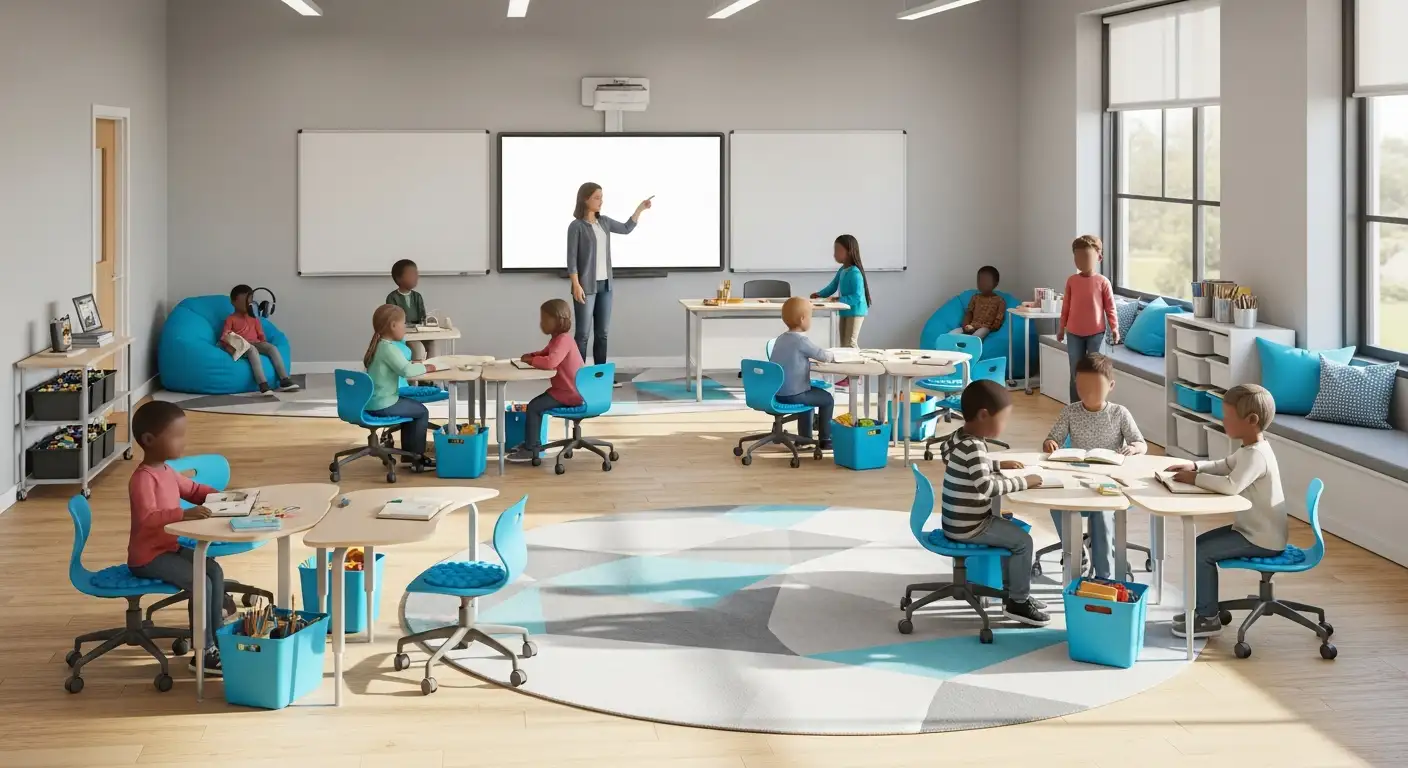How ABA Therapy Improves Communication With Teachers And Peers

Bridging Communication Gaps with ABA Therapy
Applied Behavior Analysis (ABA) therapy has emerged as a pivotal intervention for children with autism spectrum disorder (ASD), especially in enhancing communication with teachers and peers. Through a scientifically-supported and individualized approach, ABA therapy fosters essential social skills, facilitating meaningful interactions across educational and social settings. This article explores how ABA therapy systematically improves communication abilities, enabling children with autism to navigate the complexities of social engagement with greater confidence and ease.
Understanding ABA Therapy: Foundations and Framework

What is Applied Behavior Analysis (ABA) therapy and how is it used to support individuals with autism?
Applied Behavior Analysis (ABA) therapy is a scientifically-supported method that helps children with autism develop new skills and reduce challenging behaviors. It uses behavioral principles to create structured, individualized plans that address each child's unique needs. These plans focus on areas like communication, social skills, and daily living activities. Progress is continuously monitored through data collection and assessment.
What are the core principles underlying ABA therapy?
ABA is built on the understanding of behavior–specifically, how learning occurs through interactions with the environment. One main principle is positive reinforcement, where desired behaviors are encouraged by rewarding them appropriately. This strengthens these behaviors over time. Therapists also analyze triggers and consequences surrounding behaviors to better tailor interventions.
How are individualized treatment plans developed and applied?
Each child undergoes a detailed assessment to identify their strengths and challenges. Based on this, therapists design personalized programs that focus on communication difficulties like speech delay or social interaction issues. These plans break down complex skills into smaller, teachable steps. Techniques such as Discrete Trial Training (DTT) and Pivotal Response Treatment (PRT) – which is more natural and child-led – may be used depending on the child’s needs.
What role does positive reinforcement play in ABA therapy?
Positive reinforcement is central to ABA. When a child completes a task or exhibits a desired social behavior, they're immediately rewarded with things they value, such as praise or a small toy. This encourages them to repeat the behavior, helping habits develop. For example, rewards might be used to motivate a child to maintain eye contact or take turns during play.
Who provides ABA therapy and what qualifications do they have?
ABA therapy is typically administered by trained professionals. Board-Certified Behavior Analysts (BCBAs) oversee and design programs, ensuring they meet scientific standards. Trained technicians and therapists carry out daily sessions under BCBA supervision. The professional team works closely with families to integrate therapy strategies into everyday life, improving generalization of skills.
Through these foundations and tailored strategies, ABA therapy aims to empower children with autism by enhancing communication, social skills, and independence.
Personalized Programming: Tailoring ABA to Individual Needs

What is Applied Behavior Analysis (ABA) therapy and how is it used to support individuals with autism?
ABA therapy is a scientifically supported and widely accepted intervention designed specifically for children with autism. It centers on highly individualized programming, where therapists conduct thorough assessments of each child's unique strengths and challenges. This allows the development of customized treatment plans that address specific developmental areas such as communication and social skills.
Assessment and Customized Plans
Every ABA program begins with an individualized assessment to identify communication challenges—for example, speech delays, difficulties with social communication, echolalia, or deficits in joint attention. Based on this information, therapists create personalized plans that target these specific needs, aiming to improve the child’s ability to communicate and interact socially.
Targeting Communication Challenges
Communication-focused interventions include teaching functional language through methods like Verbal Behavior Therapy (VBT), which breaks language into operants such as mands (requests), tacts (labels), echoics (repetitions), and intraverbals (conversational responses). Moreover, augmentative and alternative communication (AAC) devices like PECS and speech-generating tools are incorporated for non-verbal children to facilitate effective interaction.
Evolution of Treatment Plans and Data-Driven Progress Monitoring
ABA programs are dynamic and continually adjusted based on ongoing data collection and analysis. Progress monitoring involves tracking the child's responses and skill acquisition, allowing therapists to refine strategies to better meet evolving goals. This ensures the treatment remains relevant and effective as the child develops.
Through this personalized, data-driven approach, ABA therapy fosters meaningful communication and social growth, contributing to improved confidence, independence, and quality of life for children with autism.
Core Techniques Driving Communication Skills Enhancement

How does ABA therapy typically work in practice?
ABA therapy begins with a thorough assessment by a qualified behavior analyst to pinpoint each child's unique strengths and challenges. Therapy sessions usually last between 2 to 4 hours, meeting several times weekly. During these sessions, therapists implement structured approaches like Discrete Trial Training (DTT) and Natural Environment Teaching (NET) to develop communication skills and address behavioral concerns.
Positive reinforcement
A cornerstone of ABA, positive reinforcement involves rewarding desired behaviors to encourage their recurrence. For example, when a child attempts to communicate or responds appropriately during social interactions, immediate praise or preferred items are given. This strengthens motivation and helps establish effective communication habits.
Prompting, modeling, imitation
Therapists use prompting to guide children toward the correct response, gradually reducing help as independence grows. Modeling serves as a demonstration of communication behaviors, showing children how to express needs or respond socially. Imitation skills are also nurtured, where children learn by copying gestures, sounds, or actions, forming a foundation for language and social interaction.
Discrete Trial Training (DTT)
DTT is a highly structured teaching method that breaks skills into small, manageable steps taught in controlled settings. Each trial includes a clear instruction, a response opportunity, and immediate feedback with reinforcement. This approach efficiently targets specific communication goals like naming objects or responding to questions.
Natural Environment Teaching (NET)
NET contrasts DTT by emphasizing learning within natural, everyday contexts. Communication is encouraged during play or routine activities, promoting spontaneous language use. This technique helps children generalize skills beyond therapy sessions into daily life.
Shaping and chaining
Shaping involves reinforcing successive approximations toward a desired communication behavior, rewarding closer and closer attempts. Chaining breaks down complex behaviors, such as storytelling or conversing, into linked steps taught sequentially, allowing children to build comprehensive communication skills over time.
Together, these techniques create a dynamic and tailored framework within ABA therapy to effectively enhance communication in children with autism, fostering meaningful interaction and greater independence.
Enhancing Language Through Verbal Behavior Therapy (VBT)
What is Verbal Behavior Therapy within ABA?
Verbal Behavior Therapy (VBT) is a specialized subset of Applied Behavior Analysis (ABA) focused on language development. It emphasizes understanding and teaching language based on its functions, rather than just vocabulary or grammar.
How does VBT categorize language operants?
VBT breaks down language into distinct operants, which are functional units of communication. These include:
- Mands: Requests or commands used to express needs or wants.
- Tacts: Labels or comments about objects, actions, or events.
- Echoics: Repetitions or imitations of heard sounds or words.
- Intraverbals: Conversational exchanges where responses are related but not identical to the stimulus.
- Autoclitics: Modifiers of other verbal operants that add meaning.
How does VBT promote the functional use of language?
By teaching these operants, VBT helps children use language purposefully in everyday situations. Instead of rote memorization, children learn to communicate their needs, describe their environment, engage in conversations, and adjust their message based on context.
How is VBT applied to improve communication?
Practitioners create individualized programs focusing on these language operants, using positive reinforcement and behavioral strategies to encourage communication. Teaching may involve prompting, modeling, and naturalistic interactions, facilitating gradual mastery of functional language skills.
VBT's focus on practical communication enhances language use for social interaction and independence in children with autism.
Alternative Communication Support: AAC and PECS
What Are Augmentative and Alternative Communication (AAC) Devices?
AAC devices serve as essential tools in ABA therapy to support children with autism who have limited or no verbal communication. These devices range from simple picture-based systems to high-tech speech-generating devices, designed to facilitate understanding and expression in daily interactions.
How Does PECS Help Non-Verbal Children Communicate?
The Picture Exchange Communication System (PECS) is a widely used AAC method within ABA therapy. It enables children to use pictures to express their needs and desires, building a foundation for meaningful communication. PECS encourages active participation by having children exchange images to communicate, fostering independence and reducing frustration.
What Role Do Speech-Generating Devices Play?
Speech-generating devices are advanced AAC tools that produce spoken language digitally when activated by the user. These devices are especially helpful for children who cannot speak but can learn to operate touchscreens or buttons. They promote natural conversation and social engagement by providing a voice to non-verbal children.
How Are AAC Devices Integrated to Support Social Interaction?
In ABA therapy, AAC devices like PECS and speech-generating tools are incorporated into individualized programs to encourage social skills and communication. They help non-verbal children participate in peer interactions, understand social cues, and express themselves in various settings such as classrooms and playgrounds. Therapists and teachers often use these devices alongside behavioral strategies like prompting and modeling, ensuring children gain confidence in real-world social environments.
Promoting Social Skills: From Eye Contact to Peer-Mediated Interactions
Teaching Eye Contact, Turn-Taking, and Greetings
ABA therapy focuses on breaking down social skills into manageable steps, teaching children with autism important behaviors such as maintaining eye contact, engaging in turn-taking, and offering greetings. These foundational social skills are developed through modeling, role-playing, and positive reinforcement, helping children understand interpersonal cues and interact more confidently.
Peer-Mediated Interventions
A vital component of ABA social skills training is peer-mediated interventions. Typically developing peers are coached to model appropriate social behaviors, serving as natural communication partners. This approach encourages children with autism to engage more spontaneously in social play and conversations, promoting generalization of skills across settings.
Role-Playing and Social Stories
Role-playing exercises allow children to practice social scenarios in a structured environment, helping them recognize social cues, learn conversational skills, and develop empathy. Additionally, social stories are employed to illustrate social situations with clear expectations, easing anxiety and increasing understanding of social norms.
Practicing Social Skills in Natural Environments
ABA therapy incorporates teaching in real-world settings through Natural Environment Teaching (NET). This practice lets children use their developing skills in everyday contexts like classrooms, playgrounds, and during playdates. Group sessions and peer interactions further reinforce these skills, increasing the likelihood of continued social success.
By combining step-by-step teaching, peer involvement, role-playing, and natural environment practice, ABA therapy effectively builds meaningful social skills that enhance the independence and confidence of children with autism.
Reducing Problematic Behaviors Through Functional Communication Training (FCT)
What is Functional Communication Training (FCT)?
Functional Communication Training (FCT) is a vital component of ABA therapy that focuses on replacing challenging behaviors with appropriate communication skills. Many children with autism display behaviors such as tantrums or aggression when they struggle to express their needs or feelings. FCT teaches them to use functional communication methods instead, which helps reduce frustration and problematic behaviors.
How Does FCT Substitute Challenging Behaviors?
Instead of acting out, children learn to communicate their wants and needs using clearer, socially acceptable ways. This might include verbal requests, picture exchange systems, or other augmentative and alternative communication (AAC) devices tailored to each child's abilities. By providing children with effective communication tools, FCT minimizes the occurrence of behaviors stemming from communication frustration.
Reducing Frustration and Behavioral Issues
When children successfully express themselves, they experience less frustration, which decreases the frequency and intensity of challenging behaviors. ABA techniques, such as positive reinforcement, encourage children to use the new communication skills consistently, reinforcing positive changes.
Enhancing Reciprocal Social Interactions with Joint Attention Interventions
FCT is often combined with joint attention interventions, which help children develop the ability to share focus with others. Improving joint attention is foundational for reciprocal social interactions, enabling children to engage more fully in social settings and conversations.
Together, FCT and joint attention strategies promote smoother social exchanges, increasing the child's confidence and reducing social anxiety.
| Aspect | Description | Impact |
|---|---|---|
| Challenging Behavior Substitution | Using communication to replace behaviors like tantrums or aggression | Reduces behavioral issues caused by communication barriers |
| Communication Methods | Verbal requests, PECS, AAC devices | Provides effective tools to express needs |
| Reinforcement Strategies | Positive reinforcement encourages use of appropriate communication | Ensures skill retention and consistent use |
| Joint Attention | Techniques that promote shared focus and engagement | Supports development of reciprocal social skills |
FCT empowers children by giving them a voice, significantly improving behavior and social interaction outcomes within ABA therapy.
Classroom Success: Structured Behaviors and Group Learning
Greeting, Listening, and Following Rules
ABA therapy helps children with autism succeed in classroom settings by teaching important structured behaviors. Greeting others appropriately, listening attentively, and following rules are fundamental skills that make group environments more manageable and enjoyable for children. These behaviors are typically broken down into smaller, teachable steps and reinforced through consistent practice.
Turn-Taking and Sharing
In addition to foundational behaviors, ABA focuses on developing social skills such as turn-taking and sharing. These skills encourage positive peer interactions and help children learn cooperation and patience. Therapists use modeling, role-playing, and natural environment teaching (NET) techniques to promote these abilities in real-life scenarios.
Group Sessions with Peers
Group sessions guided by a Board-Certified Behavior Analyst (BCBA) provide structured opportunities for peer interaction and social learning. These sessions foster collaboration, allowing children to practice communication and social skills in a supportive setting. Typically developing peers may also be involved through peer-mediated interventions, further enhancing social engagement and learning.
Therapist-Guided Collaborative Play
Collaborative play activities led by therapists encourage children to interact, share, and communicate with one another. Role-playing exercises simulate social situations where children learn to recognize social cues, respond appropriately, and develop conversational skills. Positive reinforcement during these sessions motivates children to repeat desired social behaviors, building their confidence and competence.
Through these ABA techniques, children gain the skills needed to navigate classroom environments successfully, promoting better social integration, academic participation, and overall confidence.
The Role of the ABA Team: Expertise Behind the Therapy
Who provides ABA therapy and what qualifications do these professionals typically have?
ABA therapy is delivered by a specialized team composed mainly of Board Certified Behavior Analysts (BCBAs), behavioral therapists, and trained behavioral technicians.
Board Certified Behavior Analysts (BCBAs) are highly trained professionals who have completed graduate-level education in behavior analysis and earned certification through the Behavior Analyst Certification Board. They oversee the design and implementation of individualized ABA plans.
Behavioral therapists and technicians support BCBAs by applying behavioral techniques, conducting assessments like Functional Behavior Assessments, and assisting with therapy sessions. Many hold degrees in related fields such as psychology or education, alongside specialized training in ABA methods, positive reinforcement strategies, and communication interventions.
How does family involvement and monitoring contribute?
Family participation is a crucial part of ABA therapy's success. Therapists work closely with families to ensure that interventions are consistent and tailored to the child's evolving needs. Ongoing monitoring allows the ABA team to adapt strategies based on progress, ensuring effective development of communication, social skills, and behavior management.
This coordinated team effort combines professional expertise with family insights to create a supportive environment that fosters meaningful and lasting improvements for children with autism.
Early Intervention and Longevity of Benefits
Why is Starting ABA Therapy Early Important?
Early intervention with Applied Behavior Analysis (ABA) therapy can significantly influence the developmental journey of children with autism. Beginning therapy as young as 2 to 3 years old taps into critical brain development periods, allowing foundational skills such as communication and self-regulation to be established more naturally and effectively. This early start helps reduce frustrations and lessens maladaptive behaviors, setting the stage for more positive developmental outcomes.
How Does ABA Therapy Support Long-Term Social Skills Improvement?
ABA therapy systematically breaks down complex social skills into manageable components, employing strategies like positive reinforcement, role-playing, and peer interaction to build competencies such as maintaining eye contact, interpreting social cues, and turn-taking. These learned skills support children in everyday settings like classrooms and playgrounds. Importantly, these improvements are not fleeting; early and consistent intervention encourages lasting social skills that persist as the child grows.
Can Older Children Still Benefit from ABA Therapy?
While early intervention is ideal, older children and teenagers with autism also experience meaningful gains through ABA therapy. Tailored programs assess individual strengths and challenges to customize approaches that address ongoing social anxieties and emotional understanding. Techniques including video modeling, natural environment teaching, and augmentative communication devices continue to foster enhanced communication and social interaction across age groups.
What are ABA Therapy's Goals and Benefits in Autism Treatment?
The primary aim of ABA therapy in autism is to promote helpful and socially significant behaviors such as effective communication, social proficiency, independence, and academic success, while decreasing challenging behaviors. It uses an understanding of behavior influenced by environmental factors, integrating behavioral principles like the A-B-Cs model and positive reinforcement to modify and encourage desired actions. Benefits include improved language development, daily living skills, emotional regulation, and overall quality of life. Personalized and evidence-based, ABA therapy supports long-term developmental achievements, particularly when introduced early, but remains valuable throughout the individual's life.
Empowering Families: Collaboration Beyond the Therapy Setting

How can parents support social skills development?
Parents play a crucial role in reinforcing social skills learned through ABA therapy. By actively participating in their child's development, they create consistent opportunities for practice and growth. Strategies include encouraging social interaction through playdates, modeling appropriate social behavior, and creating a supportive home environment.
What is the importance of encouraging playdates and modeling behavior?
Organized playdates allow children to practice social skills like turn-taking, sharing, and greeting peers in natural settings. During these interactions, parents can model positive behaviors such as maintaining eye contact, using polite language, and responding to social cues. This hands-on involvement helps children generalize learned communication skills beyond the therapy context.
How do visual supports at home enhance communication and social learning?
Visual supports like picture cards, visual schedules, and social stories complement ABA strategies by providing clear, understandable cues for children. These tools help structure daily routines and highlight expected social behaviors, supporting children in expressing their needs and reducing anxiety. Using these supports consistently at home builds on gains achieved during therapy sessions.
Why is reinforcing communication gains outside therapy important?
Positive reinforcement remains a core component when families encourage communication attempts at home. Celebrating successes with praise, rewards, or preferred activities motivates children to continue practicing new skills. When parents collaborate with therapists to maintain consistency in reinforcement strategies, children experience improved confidence and communication success in various environments.
Unlocking Potential Through Communication
ABA therapy plays a transformative role in improving communication between children with autism, their teachers, and peers. By applying individualized, scientifically validated techniques that encompass language development, social skills training, and alternative communication support, ABA creates pathways for meaningful connections in school and social settings. Through collaboration among skilled professionals and families, children learn to express their needs, interpret social cues, and engage confidently with those around them. Early and consistent intervention further amplifies these outcomes, setting the stage for greater independence and enriched social experiences. Ultimately, ABA therapy is a vital tool in empowering children with autism to bridge communication gaps and thrive within their communities.
References
- How ABA Therapy Can Improve Communication Skills in ...
- ABA Therapy for Enhancing Social Skills in Children with Autism
- Benefits of ABA Therapy for Children with Autism
- ABA therapy enhances Social Skills - Move Up ABA
- Applied Behavior Analysis (ABA)
- Who Qualifies for ABA Therapy: Eligibility Guide
- What Does an ABA Therapy Session Look Like?
Recent articles

The Role Of ABA Therapy In Managing Perseverative Behaviors
Understanding How ABA Therapy Effectively Addresses Perseverative Behaviors

How Reinforcement Works in ABA Therapy: Best Practices
Unlocking Behavior Change: Reinforcement Strategies in ABA Therapy

Using ABA To Teach Safety Skills Like Crossing The Street
Empowering Children with Autism Through Effective Safety Training

Preparing for Transition to Adult Services With ABA Foundations
Critical Steps in Navigating Autism Transition Milestones

ABA Therapy To Reduce Escape Maintained Behaviors
Effective Strategies in ABA for Addressing Escape-Driven Behaviors

How ABA Therapy Supports Children In Building Long-Term Friendships
Fostering Lifelong Bonds: The Role of ABA in Social Skills Development



